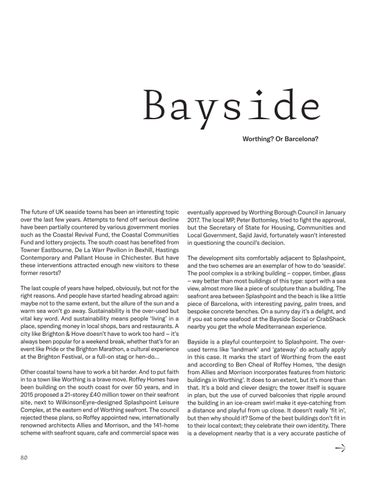Bayside Worthing? Or Barcelona?
The future of UK seaside towns has been an interesting topic over the last few years. Attempts to fend off serious decline have been partially countered by various government monies such as the Coastal Revival Fund, the Coastal Communities Fund and lottery projects. The south coast has benefited from Towner Eastbourne, De La Warr Pavilion in Bexhill, Hastings Contemporary and Pallant House in Chichester. But have these interventions attracted enough new visitors to these former resorts? The last couple of years have helped, obviously, but not for the right reasons. And people have started heading abroad again: maybe not to the same extent, but the allure of the sun and a warm sea won’t go away. Sustainability is the over-used but vital key word. And sustainability means people ‘living’ in a place, spending money in local shops, bars and restaurants. A city like Brighton & Hove doesn’t have to work too hard – it’s always been popular for a weekend break, whether that’s for an event like Pride or the Brighton Marathon, a cultural experience at the Brighton Festival, or a full-on stag or hen-do… Other coastal towns have to work a bit harder. And to put faith in to a town like Worthing is a brave move. Roffey Homes have been building on the south coast for over 50 years, and in 2015 proposed a 21-storey £40 million tower on their seafront site, next to WilkinsonEyre-designed Splashpoint Leisure Complex, at the eastern end of Worthing seafront. The council rejected these plans, so Roffey appointed new, internationally renowned architects Allies and Morrison, and the 141-home scheme with seafront square, cafe and commercial space was
80
eventually approved by Worthing Borough Council in January 2017. The local MP, Peter Bottomley, tried to fight the approval, but the Secretary of State for Housing, Communities and Local Government, Sajid Javid, fortunately wasn’t interested in questioning the council’s decision. The development sits comfortably adjacent to Splashpoint, and the two schemes are an exemplar of how to do ‘seaside’. The pool complex is a striking building – copper, timber, glass – way better than most buildings of this type: sport with a sea view, almost more like a piece of sculpture than a building. The seafront area between Splashpoint and the beach is like a little piece of Barcelona, with interesting paving, palm trees, and bespoke concrete benches. On a sunny day it’s a delight, and if you eat some seafood at the Bayside Social or CrabShack nearby you get the whole Mediterranean experience. Bayside is a playful counterpoint to Splashpoint. The overused terms like ‘landmark’ and ‘gateway’ do actually apply in this case. It marks the start of Worthing from the east and according to Ben Cheal of Roffey Homes, ‘the design from Allies and Morrison incorporates features from historic buildings in Worthing’. It does to an extent, but it’s more than that. It’s a bold and clever design; the tower itself is square in plan, but the use of curved balconies that ripple around the building in an ice-cream swirl make it eye-catching from a distance and playful from up close. It doesn’t really ‘fit in’, but then why should it? Some of the best buildings don’t fit in to their local context; they celebrate their own identity. There is a development nearby that is a very accurate pastiche of













